SHORT-WAVE-DIATHERMY
Table of Contents
DEFINATION: Short Wave Diathermy :
Short Wave Diathermy is Also called SWD – is a Electric Machine that are useful in treatment that uses electromagnetic energy to produce deep heating in joints and soft tissues. This form of heat can be applied to deeper structures than other forms of heat treatment. It uses a high-frequency electric current to stimulate heat generation within body tissues.
*the term diathermy means through heating or producing deep heating directly in the tissues of the body.
~dia- through
~thermy- heat
~it stimulates the circulation,relieve pain,enhances rate of recovery of recovery of healing tissue.
The heat can help with various processes, including :
- increasing blood flow
- relieving pain
- improving the mobility of tissues as they heal
What are the types of Diathermy?
1. Shortwave Diathermy :
Shortwave diathermy uses high-frequency electromagnetic energy to generate heat. It may be applied in pulsed or continuous energy waves. It has been used to treat pain from kidney stones, and pelvic inflammatory disease. It’s commonly used for conditions that cause pain and muscle spasms such as:
- Ligament sprains
-Muscle strains
-bursitis
-tenosynovitis
2. Microwave diathermy :
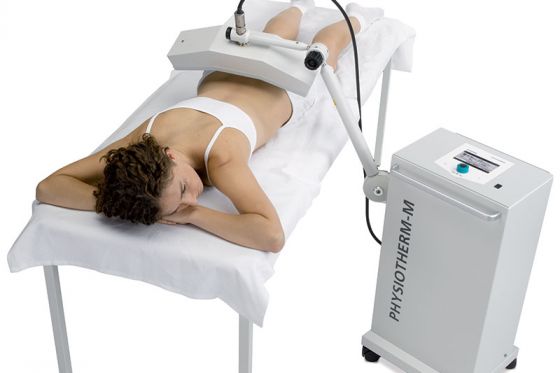
Microwave diathermy uses microwaves to generate heat in the body. It can be used to evenly warm deep tissues without heating the skin. Since it can’t penetrate deep muscles, it’s best suited for areas that are closer to the skin, such as the shoulders.
3. Ultrasound Diathermy :
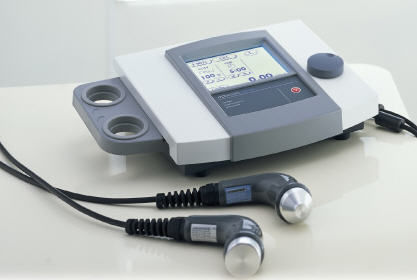
Ultrasound diathermy uses sound waves to treat deep tissues. Heat is generated by the vibration of the tissue. This promotes blood flow into the area.
Ultrasound diathermy is used for treatment of :
- musculo-skeletal sprains
- strains
- muscle spasms
- joint contractures or adhesions
- neuroma
the machine circuit
it is not possilbe to construct any mechanical device which causes sufficiently rapid movement to produce a high frequency current so this type of current is obtained by discharging a condenser through an inductance of low ohmic resistance.the basic oscillator circuit consist of a condenser and an inductance,and currents of different frequency are obtained by selecting suitable condensers and inductions.if a current of very high frequency is required the capacitance and inductance are small,while to produce a current of lower frequency a larger condenser and /or inductance are used.
the patient circuit
the circuit is coupled to the machine circuit by inductors i.e a matching high frequency current produced in the resonator circuit by electromagnatic induction.the oscilator and resonator circuit must be in resonance with each other,which requires that the product of inductance and capacitance must be same for both circuit.
the electrodes and patient’s tissues form a capacitor,the capacitance of which depends on the size of the electrodes and on the distance and material between them,and so is different for each application.
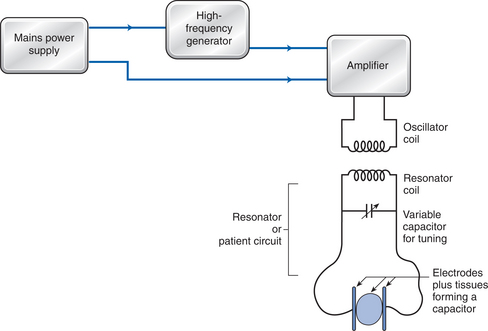
How does Short Wave Diathermy work ?

The diathermy machine does not apply heat directly to the body. Instead, the waves generated by the machine allow the body to generate heat from within the targeted tissue.
Diathermy is usually part of a complete physical therapy or rehabilitative regimen. Frequency and length of treatments vary.

Frequencies used in Diathermy :
short wave has 3 frequencies
- ~27.12 MHZ,wavelength 11 m.
- ~13.56 MHZ,wavelength 22 m.
- ~40.68 MHZ,wavelength 7.5 m.
~Shortwave diathermy uses high-frequency electromagnetic energy to generate heat. It may be applied in pulsed or continuous energy waves. It has been used to treat pain from kidney stones, and pelvic inflammatory disease. It’s commonly used for conditions that cause pain and muscle spasms such as:
~sprains
~strains
~bursitis
~tenosynovitis
What are the Benefits of Short Wave Diathermy ?
- Treating injuries with heat can increase blood flow and make connective tissue more flexible. It can also help minimize inflammation and reduce the incidence of edema, or fluid retention.
- By increasing blood flow to the site of an injury, the deep heat generated with diathermy can accelerate healing.
- Diathermy is used to treat the following conditions:
- arthritis
- back pain
- fibromyalgia
- muscle spasms
- myositis
- neuralgia
- sprains and strains
- tenosynovitis
- tendonitis
- bursitis
However, there is still not a lot of evidence to prove that diathermy is the most effective treatment for these conditions. - What are the risks of diathermy?
The electromagnetic energy used in shortwave and microwave diathermy can cause extreme heat in metal devices such as: - bone pins
- dental fillings
- metal sutures
This could cause burns in the tissue near the implant. The procedure should not be used over these areas to avoid the risk of burning.
During diathermy treatment, you become a part of the electrical field. Touching a bare metal object, including a metal part of the diathermy cabinet, can cause a shock or burn.
Diathermy should be avoided over open growth plates in children.
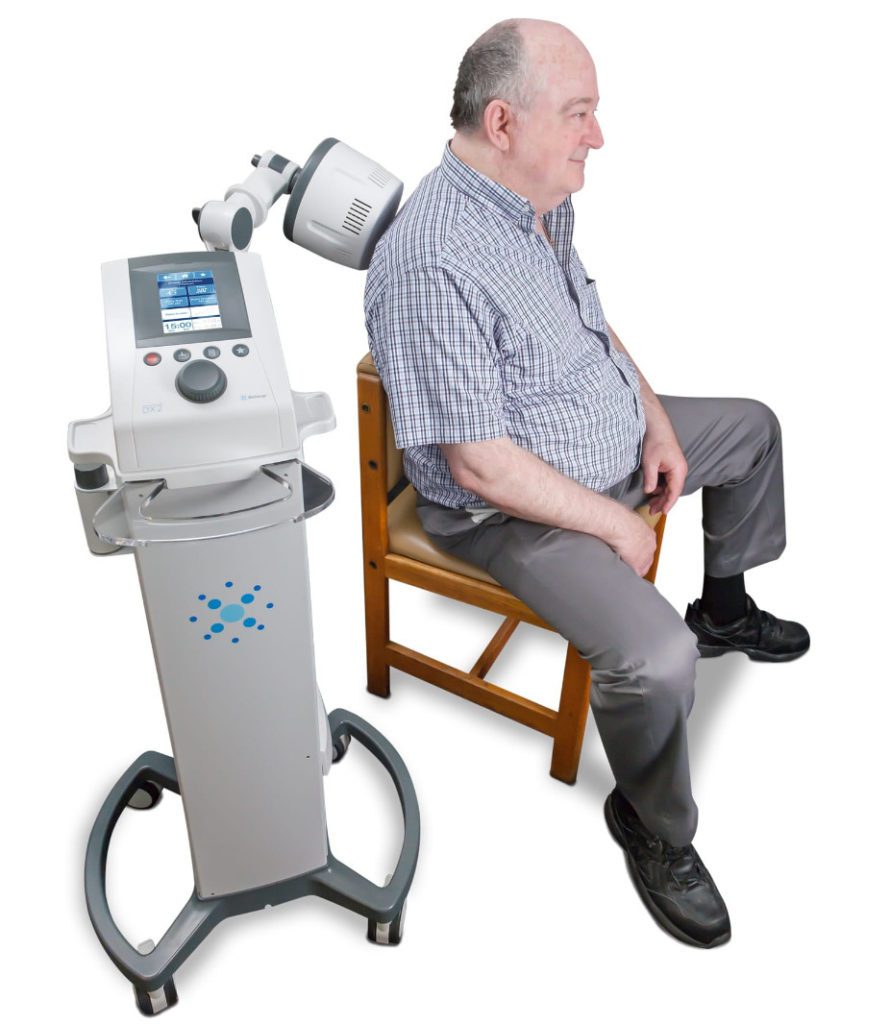
Indication of Short Wave Diathermy :-
~Disorder of Musculo-skeletal System
~Sprain (ligament)
~Strain (Muscle)
~Capsular lesion (Frozen shoulder)
~Degenerative joint disease (OA)
~Joint stiffness.
Chronic Inflammatory Condition:-
~Tendinitis
~Bursitis
~Tenosynovitis
Contraindication of Short Wave Diathermy :-
1) Haemorrhage
the heating of tissue by a diathermic current causes dilatation of blood-vessles, so it should not be employed directly after an injury or in any case where haemorrhage has recently occurred. it should not be applied to the abdomen or pelvis during menstruation nor should not be used for conditions in which haemorrhage might occur,such as gastric or intestinal disease associated with ulceration or haemophilia.
2) Venous thrombosis or phlebitis
these condition contraindication the application of swd to the area drained by the affected vessles, as the increased flow of blood may disslodge the clot or aggravate the inflammation.
3) Arterial disease
diathermy should not applied to parts which have a defective arterial blood supply. the inability of the circulation to dispere the heat could result in an increase of temperature to a level which could produce a tissue burn.
4) Pregnancy
diathermy should not be applied to the abdomen or pelvis during pregnancy.
5) Metal in the tissues :
Metal increases heating inside the tissue and chances of Burns increase any post-operative metal implants in Body.
6) disturbed skin sensation
it is safer to avoid the application of diathermy to areas where there is loss of skin sensation.
7) tumors
short-wave diathermy should not be applied not be applied in the region of malignant growths. the increase in metabolism resulting from the increase in temperature could accelerate the rate of growth.
8) x-ray
x-ray devitalize the tissues and render them more susceptible to damage. swd should therefore not be applied to areas recently exposed to therapeutic doses of x-ray.
9) patients at particular risk
it is unsafe to apply swd to patients who are unable to understand the degree of heating required and the necessity of reporting excessive heating. for this reason small children and mental defectives are not suitable for treatment. similarly it is not safe to treat unconscious patients or those who are liable to lose consciousness, such as epileptic.
Physiological Effect of Short Wave Diathermy :-
Heat Produce >> Increases Diameter of blood vessels >> Increase Blood circulation >> Remove Waste Products >>Increases Nutrients Supply in the affected area >> Relief Pain/Reduce Muscle Spasm
Therapeutic effect of Short Wave Diathermy :-
1) effect on inflammation
the dilatation of arterioles and capillaries results in an increased flow of blood the area,making available increased supply of oxygen and nutritive materials, and also bringing in more antibodies and white blood cells. increases the exudation of fluid into the tissues.these effects help to bring about the removal of waste products.
swd is particularly valuable for lesions of deeply placed structure such as hip joint ,which cannot easily be affected by other forms of electrotherapy and radiation.
2) effects in bacterial infection
inflammation is the normal response of the tissue to the presense of bacteria ,the principal features being vasodilatation , exudation of fluid into the tissue and an increase in concentration of white blood cells and antibodies in the area. heating the tissues augments these changes and so reinforces the body’s normal mechanism of dealing with the infecting organism , therefore short wave diathermy may be of value in the treatment of bacterial infections such as boils , carbuncles and abscesses.
in long standing infection no benefit is derived from the application of short wave diathermy.
3) traumatic conditions
recent injuries should be treated with the same caution as acute inflammation, as excessive heating is liable to increase the exudation of fluid from the damaged vessels. stiff joints and other after-effects of injury require stronger doses, the treatment being a preliminary to the exercise which is usually the essential part of the treatment.
4) reducing healing time
to promote the healing of ,for instance a wound , an increased blood supply to the tissues may be of assistance , provide that the vascular response to heat are normal.
5) relief of pain
it is found that a mild degree of heating is effective in relieving pain, presumably as a result of a sedative effect. it has been suggested that pain may be due to the accumulation in the tissue of the waste products of metabolism and increase flow of the blood and assists in removing of these substance.
Who’s Unqualified for diathermy?
People with implanted metal devices may be at risk for injury if they undergo any type of diathermy. These devices include:
- pacemaker
- prosthesis
- intrauterine device (IUD)
- You may not be an appropriate candidate for this treatment if you have:
- cancer
- reduced skin sensation
- peripheral vascular disease
- tissue with restricted blood supply (ischemia)
- infections
- fractured or broken bones
- bleeding disorders
- severe heart, liver, or kidney conditions
- low skin sensation
- pregnancy
- perspiration
- wound dressings
Production of SWD:-
Machine or osscillatory circuit or condenser field method.
patient or resonator circuit or inductothermy or cable wire method
size of electrode
as a general rule the electrode should be rather larger than the structure that is being treated. the electric field tends to spread,particularly at the edges, resulting in a lower density of field in the resulting in the deep part of field than in the superficial tissue.if the electrodes are large,the outer part of the field where the spread is greatest is deliberately not utilized;the structure to be heated lies in more even central part of the field. eg. treatment of the trunk electrode should be as larger as possible, while for a limb that should be rather larger than the diameter of the limb.
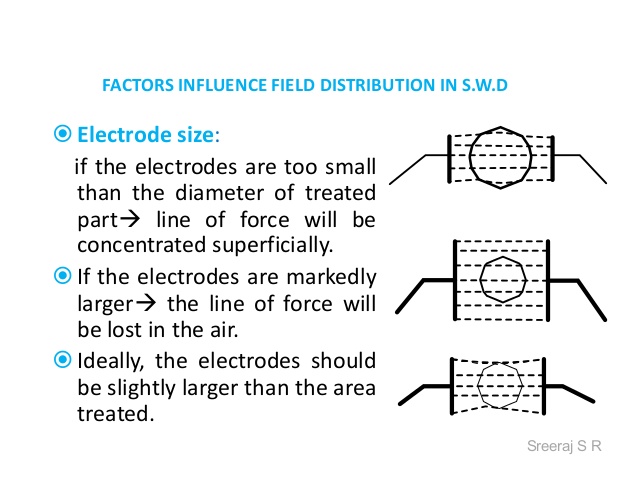
Method of application:-
- condenser field method
- cable method
*condenser field method:-
~contraplanar method
~coplanar method
~cross fire method
~monopolar method
1.contra-planer method:-
~it is the most satisfactory method,especially for the treatment of the deeply placed structures.
~in this method the electrodes are placed in opposite direction around the body area which has to be treated.
~a uniform production of electrostatic force is produced which result into deep heat compare to superficial heat.
~mostly use for the treatment of ankle,shoulder etc.
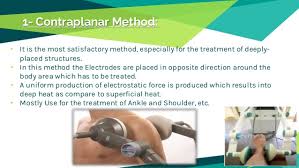
2.co-planar method:-
~in this method electrodes are placed side by side,on the same aspect of the part,provided there is adequate distance between them.
~ the distance between the two electrode should be more than the total width of spacing.

~in this method the heat is more superficial and suits certain area such as the spine , where one electrode is placed over the dorsal region,while the another placed over the dorsal region.
3.cross fire method:-
~in this method, half of the treatment period is given with the electrode of one position and then they are move into be at right angle to that obtained during the first of the treatment.
~for example, for knee joint, during the first half of session the electrodes are placed over the medial and lateral aspects of the knee, during the second half of session the electrodes are placed over the anterior and posterior aspects of the knee.

4 .monopolar method:-
~the active electrode are placed over the site of the lesion,while the indifferent one is applied to some distant part of the body.
~this method is used for very superficial lesion(face and sinuses).
*cable method:-
~arrangement at the end of the cable
~arrangement through centre of the cable
~grid arrangement
~simple pan cake method
~double pan cake method
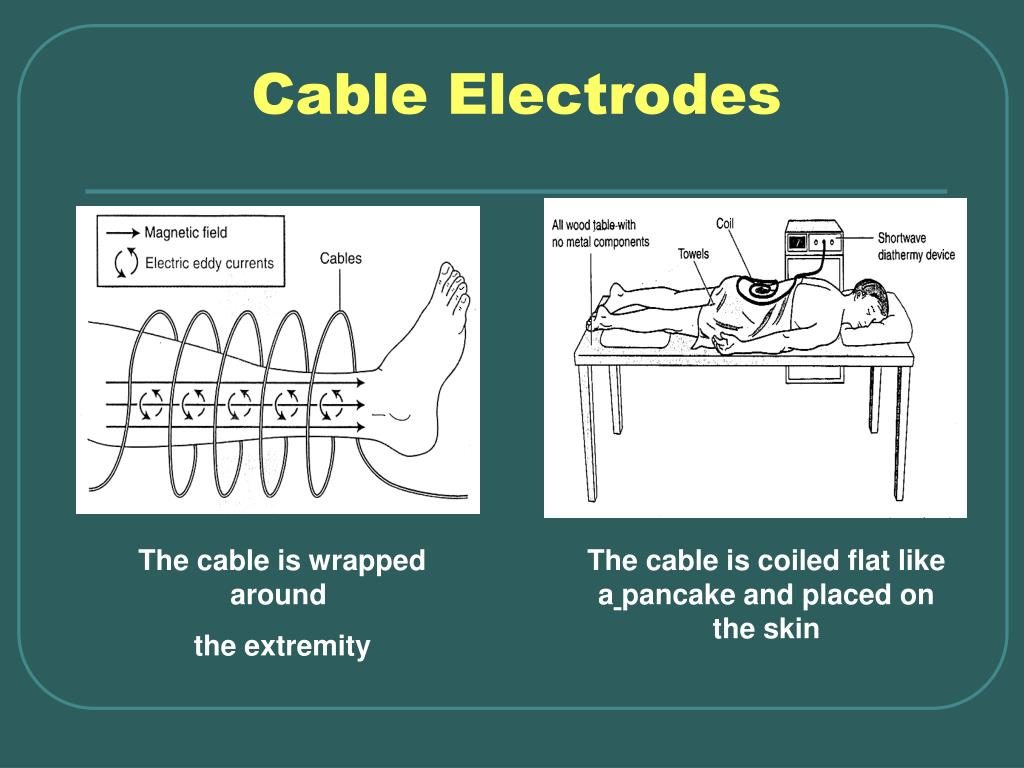
Patient preparation :-
~ensure that the patient is free of all contraindications and patient must be comfortable and the part to be treated is fully supported.
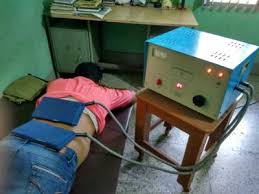
~remove all the jewellery ,coins,and metallic items from the patient .
~the treatment tissues should not be covered by clothing.
~wash the skin over the treatment area,thoroughly dry the skin prior the treatment .
~for personal safety the therapist remove watch,rings and bracelate so on.
~treatment should be on a coatch,chair or a table,which must be wooden and free from metals.
~ the skin must be dry.
~skin sensation must be tasted before treatment starts.
Monitoring the treatment :-
~before starting treatment,all meters of appartus should be on zero position.(starting position)
~select the power level according to the patients condition.
~increase the intensity gradually till the desired heating level is reached.
~immediately check for any complaint the of hot sensation.
~the physical therapist should remain within call of the patient during the whole treatment of the period.
~at the end of the treatment,the control knobs are returned to zero position,current switched off and the electrodes removed.
Danger/Precaution of SWD:-
~Shock
~Proper connection of machine and electrodes
~Ensure the earthing of machine
~Do not allow the patient to touch the unit.~burn.

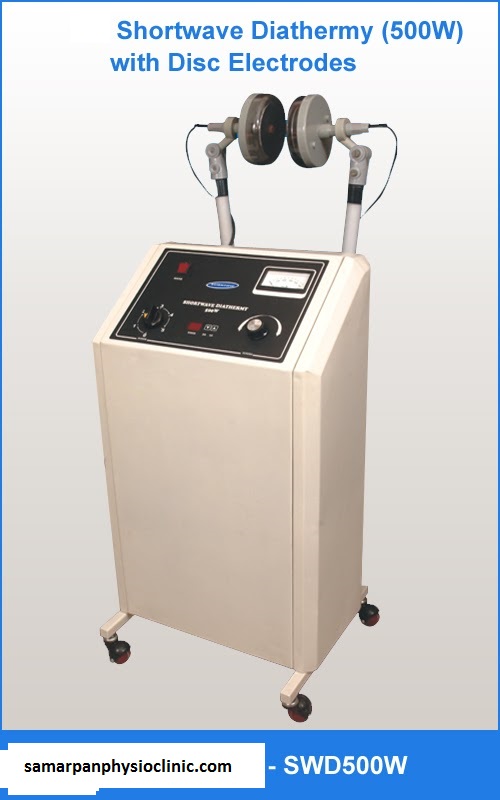

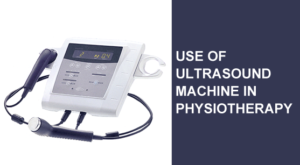

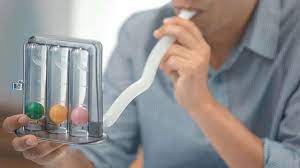
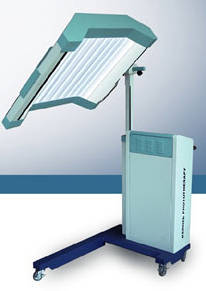
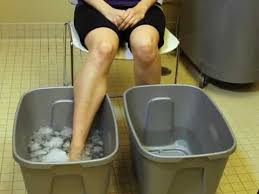

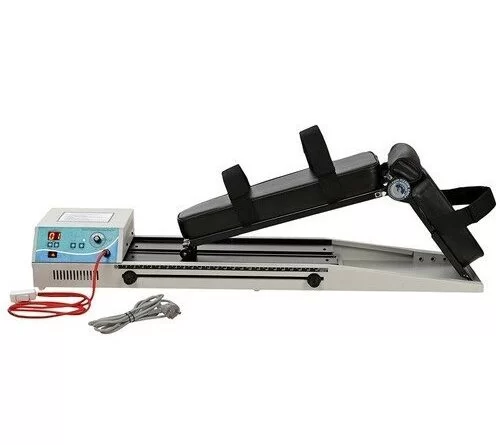
WONDERFUL & COMPLETE INFORMATION